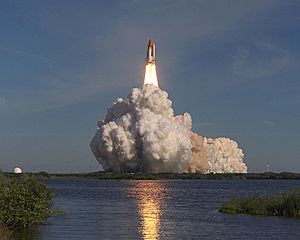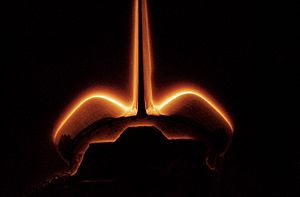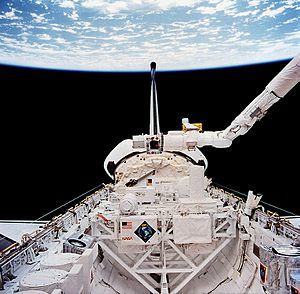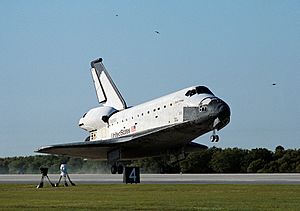STS-62 facts for kids
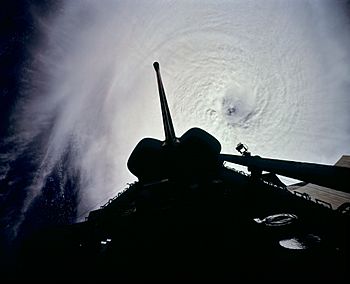
Columbia passes over Typhoon Owen.
|
|
| Mission type | Microgravity research |
|---|---|
| Operator | NASA |
| Mission duration | 13 days, 23 hours, 16 minutes, 41 seconds |
| Distance travelled | 9,366,617 kilometres (5,820,146 mi) |
| Orbits completed | 224 |
| Spacecraft properties | |
| Spacecraft | Space Shuttle Columbia |
| Landing mass | 102,861 kilograms (226,770 lb) |
| Payload mass | 8,759 kilograms (19,310 lb) |
| Crew | |
| Crew size | 5 |
| Members |
|
| Start of mission | |
| Launch date | 4 March 1994, 13:53:01 UTC |
| Launch site | Kennedy LC-39B |
| End of mission | |
| Landing date | 18 March 1994, 13:10:42 UTC |
| Landing site | Kennedy SLF Runway 33 |
| Orbital parameters | |
| Reference system | Geocentric |
| Regime | Low Earth |
| Perigee | 296 kilometres (184 mi) |
| Apogee | 309 kilometres (192 mi) |
| Inclination | 39.00 degrees |
| Period | 90.4 minutes |
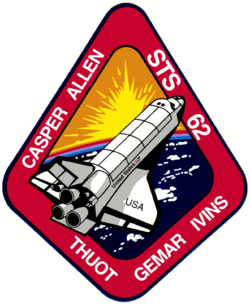 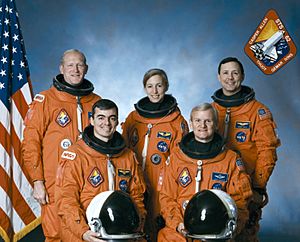 Left to right - Standing: Gemar, Ivins, Thuot; Seated: Allen, Casper |
|
STS-62 was a Space Shuttle mission flown by the orbiter Columbia in March 1994. This mission was all about science! Its main goals were to study how things behave in very low gravity, called microgravity. The crew also did experiments to see how long space flights affect the human body.
The mission lasted almost 14 days. It was even featured in a Discovery Channel TV special about the Space Shuttle program. A C.F. Martin backpacker guitar also traveled into space on Columbia during this flight.
Contents
- Meet the Crew
- Mission Highlights: What Happened in Space?
- Day 1: Launch and Orbit Setup
- Day 2: Staying Healthy and Starting Experiments
- Day 3: Exercise and Space Station Studies
- Day 4: Honoring Service and More Science
- Day 5: Earth Observations and New Technologies
- Day 6: Interviews and Crystal Growth Progress
- Day 7-8: Mid-Mission Checks and Student Questions
- Day 9: Robotic Arm Work
- Day 10: A Lighter Day
- Day 11: Lowering Orbit for More Studies
- Day 12: Testing Robotic Arm Technology
- Day 13: Lowest Orbit Yet
- Day 14: Preparing for Landing
- Images for kids
Meet the Crew
| Position | Astronaut | |
|---|---|---|
| Commander | John H. Casper This was his third space flight. spaceflight |
|
| Pilot | Andrew M. Allen This was his second space flight. spaceflight |
|
| Mission Specialist 1 | Pierre J. Thuot This was his third space flight. spaceflight |
|
| Mission Specialist 2 | Charles D. Gemar This was his third space flight. spaceflight |
|
| Mission Specialist 3 | Marsha S. Ivins This was her third space flight. spaceflight |
|
Mission Highlights: What Happened in Space?
Day 1: Launch and Orbit Setup
On Friday, March 4, Columbia launched into space. The crew worked to get the orbiter ready for its time in orbit. They opened the cargo bay doors and started activating some of the science experiments. One important step was a short engine burn to make Columbia's orbit more circular.
Day 2: Staying Healthy and Starting Experiments
On Saturday, March 5, the astronauts focused on their health. They used exercise equipment to keep their muscles strong in weightlessness. Pilot Andrew Allen and Charles Gemar also used a special device called the Lower Body Negative Pressure Container. This device helps their bodies get used to Earth's gravity again.
Mission specialists Pierre Thuot and Marsha Ivins began experiments on growing protein crystals. Scientists on Earth helped control other experiments in the cargo bay.
Day 3: Exercise and Space Station Studies
On Sunday, March 6, the crew continued their medical studies and exercise. They used a stationary bicycle with new shock-absorbing springs. This helped keep vibrations low, which was important for sensitive experiments.
Astronaut Charles Gemar worked with a model of a space station structure. He studied how it behaved in weightlessness. This helped engineers design future space stations. The crew also took photos of the "shuttle glow." This is a light created when the orbiter's skin reacts with gases in space.
Many experiments in the cargo bay kept collecting data. Scientists were excited about the Critical Fluid Light Scattering Experiment, called ZENO. They were close to finding the "critical temperature" of xenon. This is a special point where a fluid acts like both a gas and a liquid. Understanding this helps scientists learn about how matter behaves.
Other experiments, like the Isothermal Dendritic Growth Experiment (IDGE), studied how crystals grow in space. The Advanced Automated Directional Solidification Furnace (AADSF) grew special semiconductor crystals. These experiments help create better materials for technology.
Day 4: Honoring Service and More Science
Monday, March 7, started with music honoring the U.S. Armed Forces. Each crew member represented a different branch of the military.
The crew continued their science work. They checked on the protein crystal growth experiments and rodents. Charles Gemar kept working with the Middeck 0-Gravity Dynamics Experiment. This experiment helps understand how large structures, like the International Space Station, behave in space.
Commander Casper gave a presentation about the Space Acceleration Measurement System (SAMS). This system measures tiny vibrations on the Shuttle. These measurements help scientists adjust their experiments for the best results.
Scientists on Earth controlled many experiments, including the Space Shuttle Backscatter Ultraviolet (SSBUV) instrument. They used SSBUV to try and detect sulfur dioxide from volcanoes. This helps fine-tune satellites that monitor Earth's atmosphere.
The ZENO experiment team believed they had found the critical point of xenon. They observed the fluid becoming "milky" as laser light passed through it. The MEPHISTO furnace also made progress in studying how metals solidify.
The IDGE team was happy with their crystal growth results. They grew dendrites, which are tree-like crystal structures, at different temperatures. The AADSF continued to grow a special crystal used in infrared detectors.
Day 5: Earth Observations and New Technologies
On Tuesday, March 8, the crew continued their daily exercise and photography. They also kept an eye on the crystal growth experiments.
Scientists on the ground used the Space Shuttle Backscatter Ultraviolet instrument. They studied gases from volcanoes in Mexico and Central America. They also looked at industrial gases over China and Japan.
The Office of Aeronautics and Space Technology-2 (OAST-2) package tested new materials for future spacecraft. They exposed materials to the space environment. They also tested a new cooling technology and studied how the orbiter interacts with atomic oxygen.
Day 6: Interviews and Crystal Growth Progress
On Wednesday, March 9, the crew focused on experiments in the middeck. Charles Gemar continued his work with the Middeck 0-Gravity Dynamics Experiment. Andrew Allen spoke with reporters from Earth. He talked about the medical tests the crew did to understand how the human body changes in space.
Other crew members checked on protein crystal growth and looked for any debris impacts on the orbiter's windows. They also exercised using the Shuttle's ergometer.
Scientists reported that the USMP-2 experiments were going very well. The ZENO team had confirmed the critical point of xenon. The AADSF continued to grow a high-quality crystal. The IDGE team was pleased with the number and quality of dendrites they had grown. SAMS kept providing data on vibrations to help other experiment teams.
Day 7-8: Mid-Mission Checks and Student Questions
On Thursday, March 10, Commander Casper shared good news with Pilot Allen. Allen was selected for a promotion in the U.S. Marine Corps.
Friday, March 11, marked the middle of the mission. Commander Casper checked several of the environmental control systems. Columbia also changed its position in space for the first time. This allowed for different exposures for the Long Duration Space Environment Candidate Material Exposure (LDCE) experiment. This experiment tested how different materials used in space vehicles reacted to the space environment.
Mission specialist Marsha Ivins answered questions from students at the Bronx High School of Science. They asked about the microgravity experiments and living in space.
Day 9: Robotic Arm Work
On Saturday, March 12, the crew continued experiments like Auroral Photography and Commercial Protein Crystal Growth. Later, they used the Remote Manipulator System, or robotic arm. They used its camera to help troubleshoot an issue with another instrument in the cargo bay.
Day 10: A Lighter Day
Sunday, March 13, was a more relaxed day for the crew. They had some time off in the morning. In the afternoon, they worked on middeck experiments. The crew also held a news conference from space, answering questions about the mission and the future International Space Station.
Day 11: Lowering Orbit for More Studies
On Monday, March 14, the crew lowered Columbia's orbit. They fired the Shuttle's engines twice to drop about 37 kilometres (20 nmi) closer to Earth. This lower orbit increased the "shuttle glow" effect. This allowed the OAST-2 instruments to study how the orbiter interacts with gases like atomic oxygen and nitrogen.
They released nitrogen gas from a canister and studied its effect on a special plate. Columbia also did 360-degree spins to allow the OAST-2's Spacecraft Kinetic Infrared Test instrument to collect data.
Ivins and Gemar tested a new tracking system for the robotic arm. This system helps astronauts precisely move the arm. The crew also continued their daily exercise routine.
Day 12: Testing Robotic Arm Technology
On Tuesday, March 15, the crew continued testing new technologies for the Shuttle's robotic arm. Ivins, Thuot, and Gemar took turns operating the arm. They tested its ability to insert pins into tight sockets. They also tested a force sensor that measured forces created by arm movements.
Gemar and Allen continued their sessions in the Lower Body Negative Pressure device. The OAST-2 experiments remained a focus in the cargo bay. The Space Shuttle Backscatter Ultraviolet instruments also continued to take readings. These readings help calibrate satellites that monitor Earth's ozone layer.
Day 13: Lowest Orbit Yet
On Wednesday, March 16, Columbia changed its orbit again. The crew fired the engines to reach the lowest orbital altitude of any Shuttle flight up to that date. This elliptical orbit had a high point of 260 kilometres (140 nmi) and a low point of 194 kilometres (105 nmi). This lower orbit was needed for more detailed observations of the "shuttle glow" effect.
Astronaut Thuot reported that the glow was much brighter at this lower altitude. The crew also activated the Limited Duration Candidate Materials Exposure (LDCE) experiment again. This exposed materials to the low-orbit environment. They also continued testing the robotic arm's magnetic grapple system and force sensor.
Day 14: Preparing for Landing
On Thursday, March 17, the crew prepared for their return to Earth. They performed final checks of the spacecraft's systems. Commander Casper and Pilot Allen test-fired the steering jets. They also practiced landings using a computer simulation. Charles Gemar spent four hours in the Lower Body Negative Pressure Device.
Marsha Ivins powered down the robotic arm and secured it. Pierre Thuot finished the protein crystal growth experiments. The crew conducted a few more observations of the "shuttle glow" effect. They also stowed away equipment and prepared Columbia for landing.
On Friday, March 18, 1994, Columbia fired its engines to begin its descent. The Space Shuttle landed safely on Runway 33 at the Kennedy Space Center Shuttle Landing Facility at about 8:10 AM EST.
Images for kids


